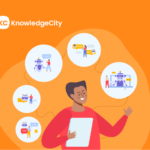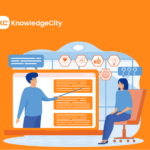L&D teams are often asked to improve coaching across the organization, yet the path forward isn’t always clear. Managers attend a session or review a guide, but when it’s time to handle a difficult conversation or guide a struggling employee, they revert to old habits. They offer advice too quickly, skip follow-ups, or wait for HR to step in. Over time, employees begin to disengage, not because their managers don’t care, but because the support they need never quite arrives.
This disconnect doesn’t come from lack of effort. It comes from a lack of structured, relevant, and applied training. Coaching isn’t something managers figure out on their own. It needs to be taught the same way any other core skill is taught, through targeted learning, real practice, and reinforcement that fits into daily work.
The six areas below outline where L&D should focus to close this gap and help managers show up more effectively in the moments that matter most.
1. Help Managers Identify the Right Moments for Coaching
Many coaching breakdowns happen before the conversation begins. Managers misjudge when coaching is needed. They might act too late, or step in with solutions when reflection is needed instead.
What to build
- A set of behavior-based triggers for coaching moments. For example:
- A team member repeats the same issue across multiple 1:1s
- Performance goals are being missed without a clear explanation
- Feedback has been given but no behavior has changed
- The employee seems unclear or uncertain during key projects
- A situational assessment toolkit with sample emails, Slack messages, and behaviors where coaching may apply
- Role-specific guides. For example: Line managers might need help with performance coaching, while senior leaders might need tools for strategic thinking sessions
How to use it
Turn the toolkit into a quick diagnostic checklist inside your manager resource hub or 1:1 templates.
2. Offer More Than One Coaching Framework
Coaching programs often rely on one model. This limits flexibility. Managers face a range of situations like career talks, performance issues, mindset shifts, that require different coaching structures.
What to include
- A coaching menu that includes 3–4 common formats. For example:
- Reflective coaching for unclear blockers
- Goal-driven coaching for progress and planning
- Corrective coaching for performance concerns
- Decision support for trade-offs and ownership
- An interactive scenario selector, where managers choose a real situation and get a matching framework
- Short reference cards or embedded guides linked from your LMS or team platform
How to use it
Assign a practical simulation per format in your training series. Make sure each includes manager-specific phrasing and a real-world prompt from your organization.
3. Shift Coaching Focus From Behavior to Thinking Patterns
Effective coaching doesn’t stop at actions. It helps employees work through flawed reasoning, fear, or blind spots. Most managers don’t know how to spot or respond to those thinking traps.
What L&D can develop
- A thinking map that helps managers spot stuck patterns like:
- Blame shifting
- Overgeneralizing
- Fear of failure
- Avoiding responsibility
- Practice modules where managers learn to use neutral, open-ended questions that shift the employee’s view
- A coaching clarity tracker like a short template that managers use post-conversation to reflect on how the employee’s thinking changed
How to use it
Use recorded manager 1:1s (with consent) to review patterns. Invite peer feedback based on whether the manager coached for insight or surface-level action.
4. Link Feedback Directly to Coaching Follow-Ups
Most feedback training stops after the message is delivered. But impact only happens when feedback becomes part of a plan. Coaching helps translate feedback into growth.
What to implement
- A four-step feedback-to-coaching protocol:
- Share specific behavior-based feedback
- Ask for employee interpretation
- Co-create one improvement step
- Set a timeline for check-in
- Templates with examples tailored by role and department
- A lightweight follow-up tracker in your HRIS or 1:1 platform where managers log coaching steps and update progress
How to use it
Train managers to turn performance reviews and informal feedback into coaching loops. Include templates in your performance calibration toolkit.
5. Train Managers to Coach Decision Quality
Many employees stall because they aren’t confident in their choices. Coaching should help them think through options, clarify trade-offs, and move forward without being told what to do.
Build this into your program
- Decision coaching tools, such as:
- Criteria mapping: What matters in this choice
- Option sorting: What has and hasn’t been tried
- Impact review: What risks exist and what support is needed
- Practice sessions using real decisions from the manager’s current team
- A decision coaching worksheet that employees fill out ahead of a coaching meeting to prepare their own thinking
How to use it
Add decision coaching templates into your onboarding for new managers or promote them during goal-setting and planning cycles.
6. Reinforce Coaching Habits Through Systems, Not Memory
Even strong coaching skills fade without reinforcement. Instead of repeating training, build light systems that remind, prompt, and support managers weekly.
What to embed
- Coaching prompts in calendar invites or meeting agendas
- A monthly challenge, such as:
- Use a thinking map in your next 1:1
- Guide a team member through a work-related decision
- Turn feedback into a coaching plan and follow up
- Quarterly coaching circles, where small groups of managers meet to share one coaching win and one coaching miss
- Add a coaching effectiveness field in employee feedback surveys (e.g., “My manager helps me think through challenges clearly.”)
How to use it
Build these habits into existing manager workflows. Add prompts into HR systems, leadership newsletters, and team operating rhythms.
How KnowledgeCity Strengthens Coaching Through Skills-Based Learning
If coaching is going to drive performance, it has to be treated like any other business-critical skill, defined, measured, and embedded into day-to-day operations. It’s not enough to inspire managers. L&D teams must equip them with frameworks they can use mid-project, mid-conflict, and mid-decision. That’s where coaching becomes less of a leadership trait and more of an operating standard.
KnowledgeCity supports this shift with targeted, skills-based training built for real-world application. Our courses are structured to help managers recognize coaching opportunities, navigate complex conversations, and follow through in ways that support business results. If you’re designing a coaching initiative that needs more than surface-level learning, our platform gives you the depth, flexibility, and control to make it stick.
Subscribe to Our Newsletter
Join 80,000+ Fellow HR Professionals. Get expert recruiting and training tips straight
to your inbox, and become a better HR manager.

 KnowledgeCity
KnowledgeCity 











